4-H Forestry Competition Handbook
Content
Forest Insect and Disease Identification
Official 4-H Forestry Tree Identification List
Junior Tree Identification Score Sheet
Senior Tree Identification Score Sheet
Measurement of Standing Trees Study Guide
Junior Tree Measurement Score Sheet
Senior Tree Measurement Score Sheet
Official 4-H Forest Insect and Disease List
Senior Forest Insect and Disease Identification Score Sheet
General Information
The Mississippi 4-H Forestry Competition tests forestry knowledge and skills. This competition is held at the district and/or state levels. Some counties have local competitions to select a forestry team to represent the them at the district competition. County competitions are strongly encouraged, because they promote 4-H forestry activity in the county, but they are not required.
The 4-H Forestry Competition is modeled after the National 4-H Forestry Invitational held annually at Jackson’s Mill State 4-H Camp in West Virginia. This helps Mississippi 4-H’ers to be prepared to advance from their county competitions all the way to the National 4-H Forestry Invitational.
The Forestry Competition is conducted at the junior and senior levels, but only seniors may compete at the state and national levels.
The junior competition is conducted only at the district level and includes three events:
- Tree Identification
- Tree Measurement
- Forest Knowledge
The senior competition is held at the district and/or state level and includes four events:
- Tree Identification
- Tree Measurement
- Forest Knowledge
- Forest Insect and Disease Identification
Goals and Objectives
The purpose of the 4-H Forestry Competition is to provide opportunity for 4-H forestry members to:
- Develop leadership talents, achieve character development, and make new friends.
- Appreciate the need and importance of conserving forests as a source of products, services, values, and benefits necessary for quality living.
- Acquire information and understanding of practical skills in forest management, use of forest products, and appreciation of forest ecology.
- Realize that privately owned forest products provide most of the raw material used by forest products manufacturers in Mississippi.
The competition, while competitive in nature, is intended and managed to provide a well-rounded forestry educational experience. Study references are available from Extension Forestry, unless otherwise noted.
General Rules
- The forestry competition will have at least three parts: Tree Identification, Tree Measurement, and Forest Knowledge (seniors will also compete in Forest Insect and Disease Identification).
- This competition is a team event. A team will have three or preferably four members. Individuals may compete, but they will not be eligible to advance in district and state competition. Senior teams that place first, second, and third in the district competition, if one is held, will advance to compete in the state competition, with a chance to represent Mississippi at the National 4-H Forestry Invitational.
- Each contestant must bring a pencil, clipboard, and tree scale stick. It is also suggested that contestants wear appropriate field clothes (jeans and boots), since part of the contest is held outdoors.
- Calculators are permitted.
- In scoring, the lowest combined score of a four-member team is dropped and the top three combined scores used as the team total. If a team has only three members, the low score is not dropped.
- Ties are broken with the highest scores in (1) Forest Knowledge, (2) Tree Identification, and (3) Tree Measurement.
Junior Competition
The junior competition is similar, but less demanding, than the senior competition. It is designed to make junior 4-H forestry contestants familiar with the competition, so they will develop into strong competitors at the senior level.
Tree Identification
- Junior participants are required to identify 20 trees from leaf mounts, photos, or specimens in the field. MSU Extension Publication 146 Know Your Trees contains tree species included in this portion of the contest.
- The contest is conducted indoors like a “lab practical.” Participants will be given no more than 1 minute per station to identify each leaf mount. The contest will have a time limit of 30 minutes.
- The correct answer for each tree is the common name shown on the Official 4-H Forestry Tree Identification List (page 5). This list is derived from the common names given in MSU Extension Publication 146 Know Your Trees.
- The answer given must be the complete, correctly spelled common name as given in the Official 4-H Forestry Tree List. One-half credit is given if the name is incomplete or misspelled. Example: If the species is river birch, then birch will receive half credit for an incomplete common name. If birch is also misspelled, no credit is given.
- A total of 100 points is possible in this event; each answer is worth 5 points. In the case of a tie, the winner is the participant with the greatest number of correctly identified oaks, then pines, then elms.
Tree Measurement
- Participants will measure three trees using a tree scale stick. For each tree, participants will identify the common name, measure the diameter at breast height (DBH) in inches, measure merchantable height in logs, and figure the total timber volume in the measured trees. The time limit for this event is 45 minutes.
- DBH is measured in 2-inch, even-numbered-diameter classes. The correct answers for the DBH on the contest score form are even numbers, such as 10, 16, 22, and so on. A tree in the diameter range 9.1 to 11.0 inches is tallied as DBH 10 inches. In timber cruising for management purposes, it is common to tally trees in 2-inch-diameter classes.
- Merchantable height is measured in 16-foot logs and estimated to the nearest full ½ log. For example, if a tree measures 2¼ logs, it should be tallied as 2 logs, because the ¼ log is too short to make another full ½ log. When measuring logs, always round down, not up. Measure merchantable height up to an 8-inch top or a major fork in the trunk. Deciding where to “cut the tree off“ can be a judgment call based on species and log quality. However “controversial” trees will be avoided, and 4-H’ers will be given trees that will challenge their abilities to measure diameter and height only.
- DBH and merchantable height are used to determine volume of lumber in each tree by using a volume table. 4-H forestery contestants should know how to find a log volume from a volume table before coming to the contest. A volume table will be given at the contest.
- All individual tree volumes are added together to arrive at a “plot volume” that will be entered on the score sheet. Calculators are permitted.
- A total of 100 points is possible in this event. The common name, DBH, merchantable height, and volume for each tree will be valued at 5 points each. A possible maximum of 40 points will be given for the “plot volume” estimate. The “plot volume” will be scored as follows:
If the contestant’s estimate of plot volume is within:
± 5% of official volume = 40 points
± 10% of official volume = 30 points
± 15% of official volume = 20 points
± 20% of official volume = 10 points
>± 20% of official volume = 0 points
The common name given in the Tree Measurement section is the same as required in Tree Identification. The same scoring rules as Tree Identification apply.
Forest Knowledge
There is a wealth of information about forestry available through MSU Extension and the Internet. 4-H youth are encouraged to explore these resources. There is a section on Study References at the end of the Senior Competition section.
Participants will answer 20 written, multiple choice, or true-false questions on forestry subject matter taken from the listed references. The time limit for the event is 30 minutes. A total of 100 points is possible in this event, with each question worth 5 points. Forest Knowledge is designed to test the 4-H contestant’s general knowledge of important forestry concepts.
Senior Competition
The senior competition is designed to challenge participants’ skills and knowledge of forestry, while preparing them for national competition.
Tree Identification
- Senior participants are required to identify 50 trees from leaf mounts, photos, or specimens in the field. All species listed in MSU Extension Publication 146 Know Your Trees may be included in this portion of the contest.
- The contest consists of two sections: indoor and outdoor. The indoor portion is a “lab practical,” with the contestants required to identify 25 trees from leaf mounts or photos. The remaining 25 trees must be identified from live specimens in the field. Participants are given no more than 1 minute to identify each leaf mount or live specimen. The time limit for this event is 30 minutes per section.
- The correct answer for each tree is the common name shown on the Official 4-H Forestry Tree Identification List (page 53). This list is derived from the common names given in MSU Extension Publication 146 Know Your Trees.
- The answer given must be the complete, correctly spelled common name as given in the Official 4-H Forestry Tree List. One-half credit is given if the name is incomplete or misspelled. Example: If the species is river birch, then birch will receive half credit for an incomplete common name. If birch is also misspelled, no credit is given.
- A total of 100 points is possible in this event; each answer is worth 2 points. In the case of a tie, the winner is the participant with the greatest number of correctly identified oaks, then pines, then elms.
Tree Measurement
- Senior contestants will measure 10 trees using a tree scale stick. For each tree, participants will identify the common name, measure the diameter at breast height (DBH) in inches, measure merchantable height in logs, and estimate total timber volume per acre. The time limit for this event is 45 minutes.
- DBH is measured in 2-inch, even-numbered-diameter classes. For example, the correct answers for the DBH on the contest score form are even numbers, such as 10, 16, 22, etc. A tree in the diameter range 9.1 to 11.0 inches is tallied as DBH 10 inches. In timber cruising for management purposes, it is common to tally trees in 2-inch-diameter classes.
- Merchantable height is measured in 16-foot logs and estimated to the nearest full ½ log. For example, if a tree measures 2¼ logs, it should be tallied as 2 logs, because the ¼ log is too short to make another full ½ log. When measuring logs, always round down, not up. Measure merchantable height up to an 8-inch top or a major fork in the trunk. Deciding where to “cut the tree off” can be a judgment call based on species and log quality. However “controversial” trees will be avoided, and 4-H’ers will be given trees that will challenge their abilities to measure diameter and height only.
- DBH and merchantable height are used to determine volume of lumber in each tree by using a volume table given at the contest. 4-H forestry contestants should know how to find a log volume from a volume table before coming to the contest.
- All individual tree volumes are added together to arrive at a “plot volume.” This “plot volume,” multiplied by a plot size factor, yields the estimated volume per acre. The plot size is given to the contestants at the contest. Participants should come to the contest with the knowledge of how to use a plot factor. For example, if the sample plot size given is ¼ acre, then the sample plot volume must be multiplied by 4 to arrive at an estimated volume per acre. Calculators are permitted.
- A total of 100 points is possible in this event. The common name, DBH, merchantable height, and volume for each tree will be valued at 2 points each. A possible maximum of 20 points will be given for the “plot volume” estimate. The “plot volume” will be scored as follows:
If the contestant’s estimate of volume per acre is within:
± 5% of official volume = 20 points
± 10% of official volume = 15 points
± 15% of official volume = 10 points
± 20% of official volume = 5 points
>± 20% of official volume = 0 points
The common name given in the Tree Measurement section is the same as required in Tree Identification. The same scoring rules as Tree Identification apply.
Forest Knowledge
- The competition will be a test consisting of 50 multiple choice or true-false questions on forestry subject matter taken from the listed references. The time limit for the event is 45 minutes.
- A total of 100 points is possible in this event, with each question worth 2 points.
- Forest Knowledge is designed to test the 4-H contestant’s general knowledge of important forestry concepts.
Forest Insect and Disease Identification
- The contestant will be asked to identify the common name of 10 forest insects and 10 forest diseases. All species listed on the Official 4-H Forest Insect and Disease List (page 13) may be used in this event.
- The competition consists of two sections, with each section given in a “lab practical” format. Each contestant is required to identify 10 insects or insect-damaged specimens and 10 diseases or disease-damaged specimens. Pictures of the insect or disease specimen may also be used. The contestant is given no more than 1 minute per station to identify each specimen. The time limit for this event is 15 minutes maximum per section.
- The correct answer for each specimen is the common name shown on the Official 4-H Forest Insect and Disease List.
- The answer given must be the complete, correctly spelled common name as given in the Official 4-H Forest Insect and Disease List. One-half credit will be given if the name is misspelled or incomplete. Example: If the species is Nantucket pine tip moth, then tip moth will receive ½ credit. If it is also misspelled, no credit will be given.
- A total of 100 points is possible in this event, with each answer worth 5 points. Ties are broken using the participant with the greatest number of correctly named insects, then correctly named diseases.
Study References
All MSU Extension publications are available at extension.msstate.edu/publications:
- P0146 Know Your Trees
- P0160 Tree Planting Is Easy
- P1205 Welcome to 4-H Forestry
- P1250 Forestry Terms for Mississippi Landowners
- P1281 Timber Stand Improvement
- P1473 Measuring Standing Sawtimber, 4-H Forestry Project #7
- P1612 Forestry/Wildlife Myths and Misconceptions
- P1686 Making a Tree Scale Stick
- P1864 Waterfowl Habitat Management Handbook
- P2179 Ecology and Management of the Northern Bobwhite
- P2233 Streamside Management Zones and Forest Landowners
- P2283 Prescribed Burning in Southern Pine Forests: Fire Ecology, Techniques, and Uses for Wildlife Management
- P2260 Are My Pine Trees Ready to Thin?
- P2402 Mississippi Recreational Gardens: Establishing a Backyard Wildlife Habitat
- P2467 Ecology and Management of Rabbits in Mississippi
- P2466 Ecology and Management of Squirrels in Mississippi
- P2470 Managing the Family Forest in Mississippi
- P2617 What Are Genetically Improved Seedlings?
- P2822 Forest Soils of Mississippi
- P2823 Site Preparation: The First Step to Regeneration
- P3406 Wild Turkey Ecology and Management
- P3508 Geocaching in Natural Resources: Fun with Forests around Us
- P3562 The Economic Contributions of Forestry and Forest Products, Mississippi
- P3597 Wildlife Find Food in Pine Trees, Too
Additional reading that can be found online:
USDA Forest Service, Rocky Mountain Research Station. 2010. A Field Guide to Diseases and Insects of the Rocky Mountain Region. General Technical Report RMRS-GTR-241. Available online at https://www.fs.usda.gov/treesearch/pubs/37290
Mississippi Forestry Commission. 2016. Mississippi trees (2nd ed). Online at https://www.mfc.ms.gov/programs/educational-workshops/publications/
National 4-H Forestry Invitational. Training materials and References. Available online at https://4hforestryinvitational.org/training
USDA Forest Service. 2004. The Impact and Control of Major Southern Forest Diseases. Southern Forest Science: Past, Present, and Future. USDA Forest Service, General Technical Report 075. Available online at https://www.fs.usda.gov/treesearch/pubs/9678
USDA Natural Resources Conservation Service. 2019. National plants database. https://plants.sc.egov.usda.gov/home
Measurement of Standing Trees Study Guide
Purpose
Standing trees are measured to obtain an estimate of the amount of various forest products that might be cut from them. This is done to have an idea of what volume is present. Most timber sales are based on volume. All forest properties must have some estimate of total volume, volume per acre, and volume by product, so you can decide the course of your forest’s management.
Products
Forest products that may be measured are poles
and pilings, sawlogs, veneer logs, pulpwood, and fence posts.
Method
Since all trees are basically a part of a cylinder, they have a diameter and height that may be measured. Diameter of standing trees is measured by time-honored custom, at 4½ feet aboveground on the uphill side of the tree. This is abbreviated as DBH (diameter at breast height). The method to measure diameter is explained in detail.
Height of a standing tree can be measured as total (the entire height from ground line to the top of the crown) or merchantable height. Merchantable height varies, depending on the product that is to be cut from the tree. The top stem diameter is fixed by certain specifications. In 4-H Tree Measurement, this is an 8-inch top diameter. If a tree is to be cut into logs, the lengths cut will vary, depending on the demand of the mill to which the logs will go. In the Tree Measurement event, measure the tree to the nearest ½ log, a log being specified as 16 feet long.
Tools
The diameter can be measured using a caliper, diameter tape, or tree scale stick. Since the tree scale stick is to be used in the contest, the method of using it is explained.
Diameter Measurement
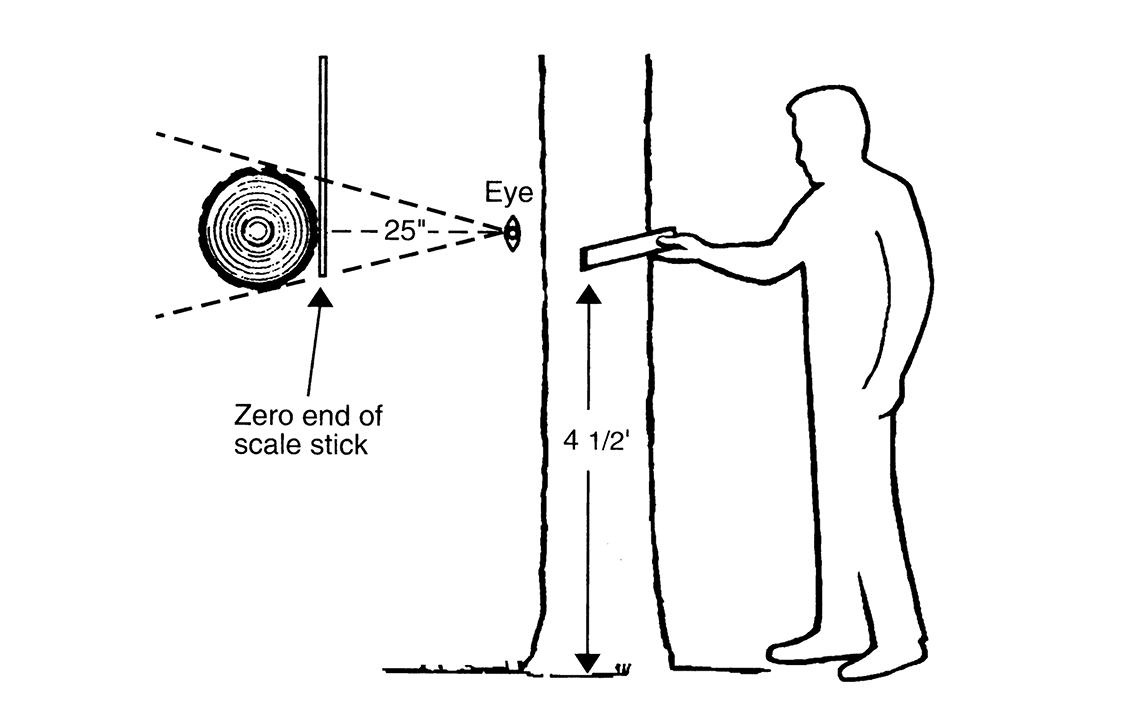
Figure 1 shows how the tree scale stick is used to find tree diameter:
Use the flat side of the stick labeled “Diameter of Tree (in inches).”
Hold the stick level against the tree at a height of 4½ feet above the ground, 25 inches from your eye. Practice to find both the 4½-foot point in relation to your height, and the 25-inch distance to your eye.
When the stick is placed against a tree, close one eye and sight at the left or zero end.
The zero end of the tree scale stick and the tree bark should be in the same line.
Do not move your head. Glance across the stick to the right-hand edge of the tree. Read the tree diameter from the stick to the nearest inch.
Height Measurement
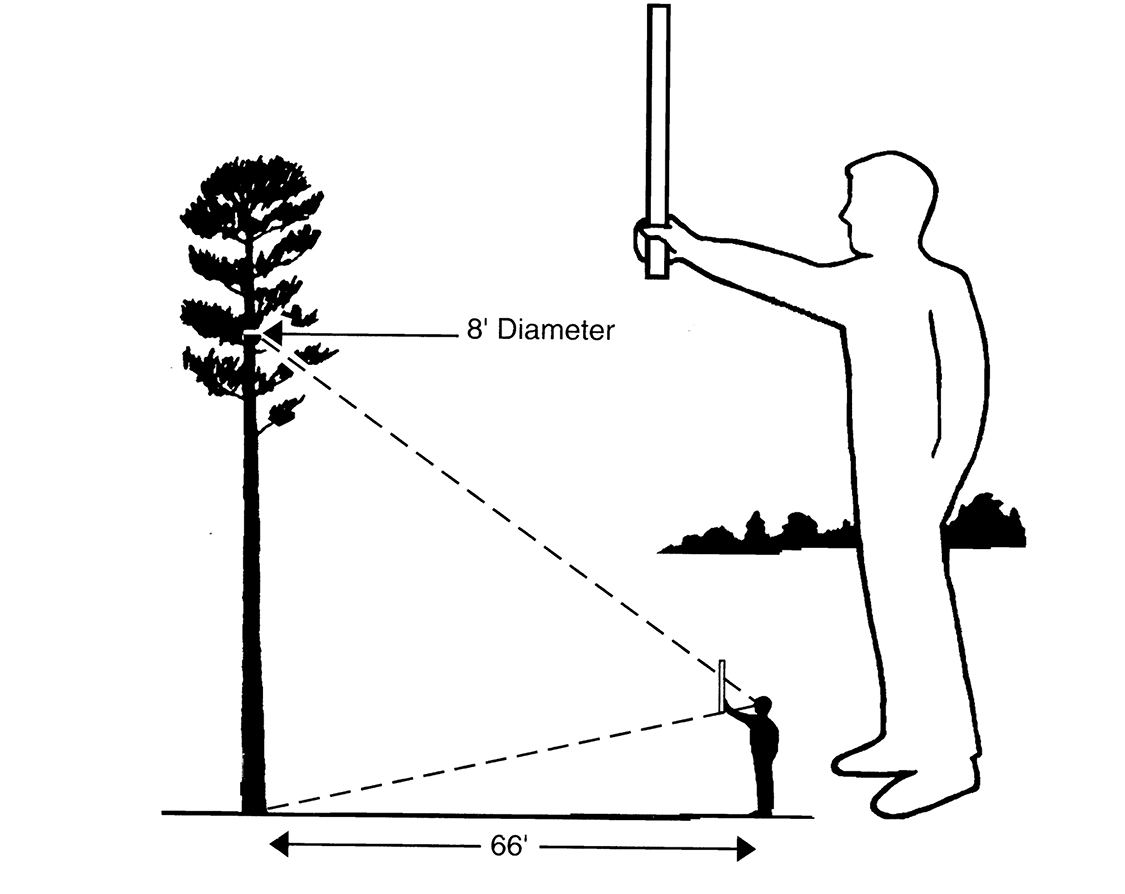
Figure 2 illustrates how to use the tree scale stick to measure height. Height is measured as follows:
Pace out 66 feet as ‘measured from the center-line of the tree in the direction to which you pace. The entire tree must be seen.
Hold the stick so that the “number of 16-foot logs” side faces you. The zero end should point toward the ground.
Plumb the stick, at 25 inches from your eye.
Sight the zero end to appear to rest at the stump height (stump height is 6 inches above the ground). Do not move your head or the stick.
Look up the stick to the point where the top of the last merchantable cut would be made in the tree, an 8-inch top diameter. The merchantable height on the stem is where the tree trunk “disappears’ behind the edge of the tree scale stick. Read sawlogs to the nearest full one-half log off the tree scale stick.
Practice on pacing is needed to find the 66-foot distance. The 25-inch distance from eye to stick is still the same as in measuring tree diameter.
Appendix
Official 4-H Forestry Tree Identification List
|
Common name |
Scientific name |
|---|---|
|
ash, green |
Fraxinus pennsylvanica |
|
ash, white |
Fraxinus americana |
|
baldcypress |
Taxodium distichum |
|
basswood* |
Tilia spp. |
|
beech, American |
Fagus grandifolia |
|
birch, river |
Betula nigra |
|
blackgum |
Nyssa sylvatica |
|
boxelder |
Acer negundo |
|
catalpa, Southern |
Catalpa bignonioides |
|
cherry, black |
Prunus serotina |
|
cottonwood, Eastern |
Populus deltoides |
|
dogwood, flowering |
Cornus florida |
|
elm, American |
Ulmus americana |
|
elm, slippery |
Ulmus rubra |
|
elm, winged |
Ulmus alata |
|
hickory* |
Carya spp. |
|
holly, American |
Ilex opaca |
|
honeylocust |
Gleditsia triacanthos |
|
hophornbeam, Eastern |
Ostrya virginiana |
|
hornbeam, American |
Carpinus caroliniana |
|
locust, black |
Robinia pseudoacacia |
|
magnolia, Southern |
Magnolia grandiflora |
|
maple, red |
Acer, rubrum |
|
maple, silver |
Acer saccharinum |
|
mulberry, red |
Morus rubra |
|
oak, black |
Quercus velutina |
|
oak, blackjack |
Quercus marilandica |
|
oak, bluejack |
Quercus incana |
|
oak, cherrybark |
Quercus pagoda |
|
oak, laurel |
Quercus laurifolia |
|
oak, live |
Quercus virginiana |
|
oak, Northern red |
Quercus rubra |
|
oak, nuttal |
Quercus texana |
|
oak, overcup |
Quercus lyrata |
|
oak, post |
Quercus stellata |
|
oak, scarlet |
Quercus coccinea |
|
oak, shumard |
Quercus shumardii |
|
oak, Southern red |
Quercus falcata |
|
oak, swamp chestnut |
Quercus michauxii |
|
oak, water |
Quercus nigra |
|
oak, white |
Quercus alba |
|
oak, willow |
Quercus phellos |
|
orange, Osage |
Maclura pomifera |
|
pecan |
Carya illinoensis |
|
persimmon, common |
Diospyros virginiana |
|
pine, loblolly |
Pinus taeda |
|
pine, longleaf |
Pinus palustris |
|
pine, shortleaf |
Pinus echinata |
|
pine, slash |
Pinus elliotii |
|
pine, spruce |
Pinus glabra |
|
poplar, yellow |
Liriodendron tulipifera |
|
redbud, Eastern |
Cercis canadensis |
|
redcedar, Eastern |
Juniperus virginiana |
|
sassafras |
Sassafras albidum |
|
sugarberry |
Celtis laevigata |
|
sweetbay |
Magnolia virginiana |
|
sweetgum |
Liquidambar styraciflua |
|
sycamore, American |
Platanus occidentalis |
|
tupelo, water |
Nyssa aquatica |
|
walnut, black |
Juglans nigra |
|
willow, black |
Salix nigra |
*Contestants are only responsible to identify the genus level for basswood and hickory.
Junior Tree Identification Score Sheet
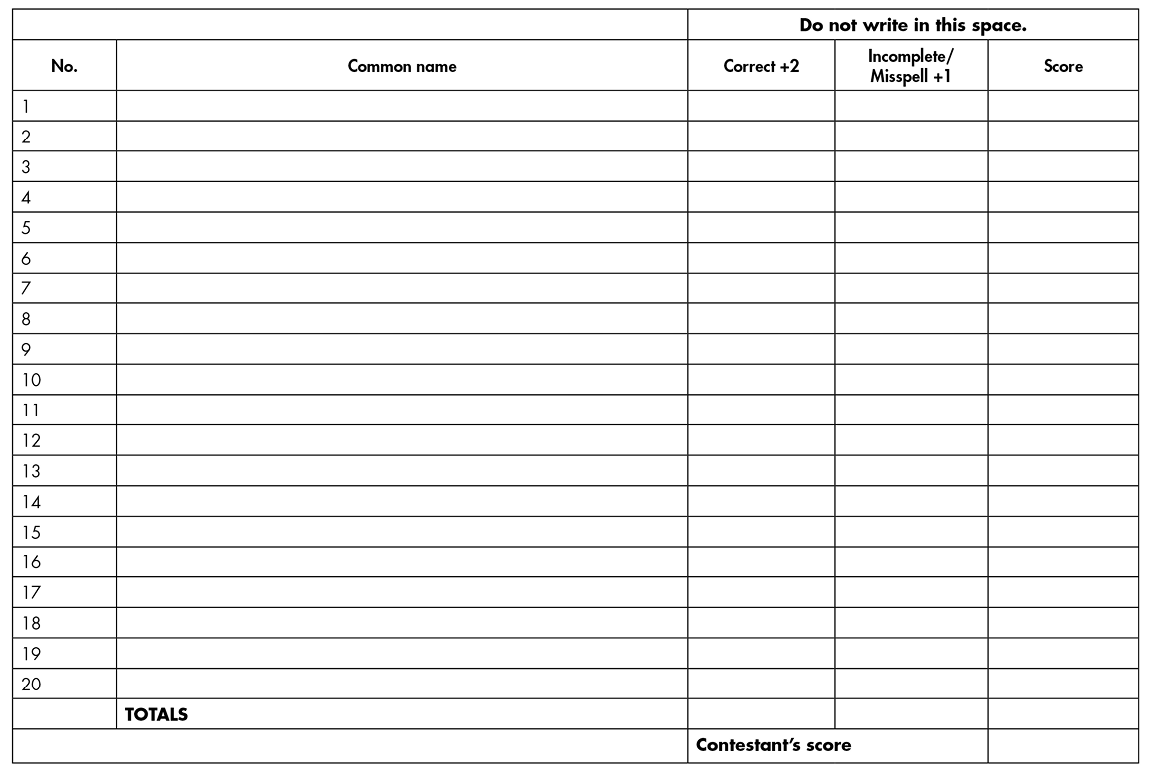
Senior Tree Identification Score Sheet
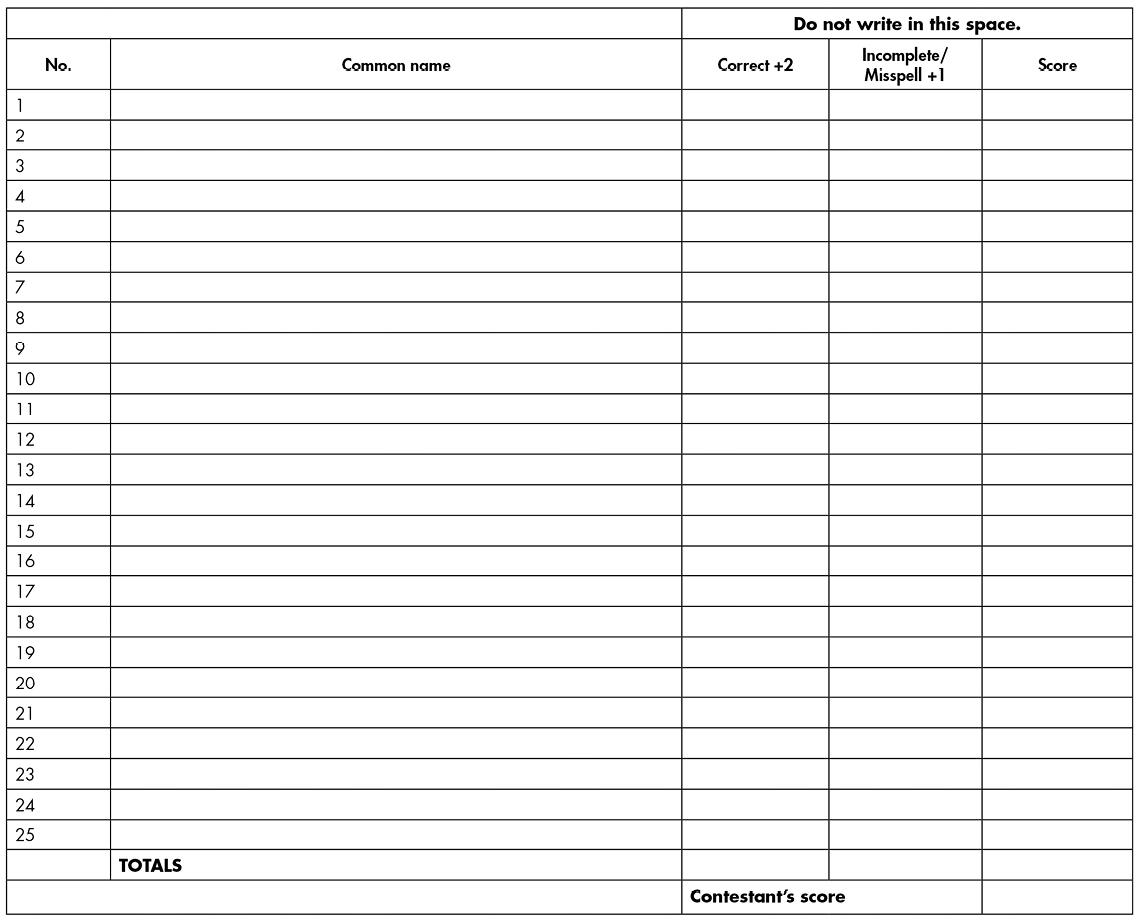
Junior Tree Measurement Score Sheet

Senior Tree Measurement Score Sheet
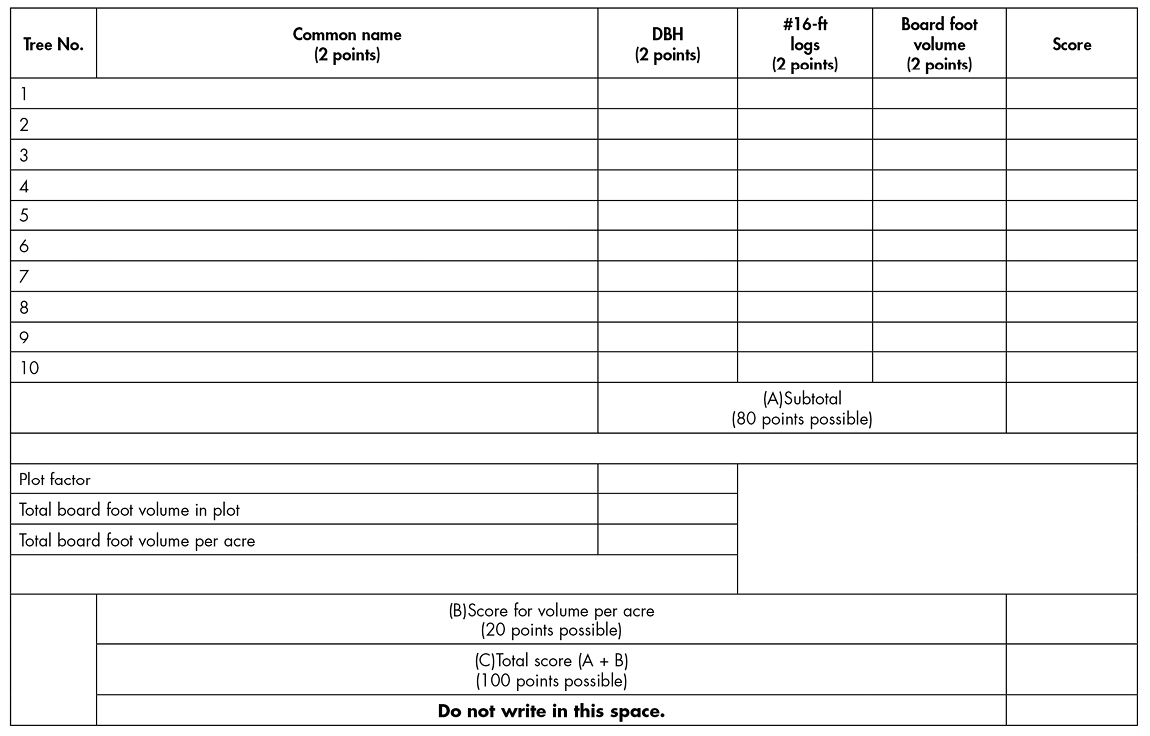
Sample Volume Table
Doyle Log Rule, Form Class 78
Gross tree volume in board feet, by number of usable 16-foot logs
|
Tree |
Tree height (16-ft logs) |
||||||||
|---|---|---|---|---|---|---|---|---|---|
|
1 |
1½ |
2 |
2½ |
3 |
3½ |
4 |
4½ |
5 |
|
|
10 |
18 |
22 |
26 |
28 |
30 |
32 |
33 |
|
|
|
12 |
33 |
42 |
51 |
57 |
63 |
65 |
68 |
71 |
|
|
14 |
54 |
70 |
85 |
96 |
107 |
113 |
119 |
125 |
|
|
16 |
79 |
98 |
128 |
146 |
165 |
178 |
189 |
198 |
|
|
18 |
109 |
144 |
179 |
207 |
235 |
254 |
272 |
283 |
|
|
20 |
144 |
193 |
242 |
281 |
320 |
348 |
375 |
396 |
417 |
|
22 |
184 |
249 |
313 |
366 |
418 |
455 |
484 |
525 |
557 |
|
24 |
228 |
310 |
392 |
459 |
527 |
574 |
645 |
667 |
713 |
|
26 |
279 |
380 |
482 |
566 |
651 |
713 |
775 |
835 |
894 |
|
28 |
331 |
454 |
577 |
682 |
787 |
861 |
935 |
1,011 |
1,087 |
|
30 |
392 |
539 |
687 |
814 |
940 |
1,032 |
1,122 |
1,216 |
1,310 |
|
32 |
457 |
631 |
805 |
958 |
1,110 |
1,222 |
1,334 |
1,441 |
1,548 |
|
34 |
525 |
727 |
929 |
1,106 |
1,284 |
1,416 |
1,548 |
1,675 |
1,803 |
|
36 |
599 |
834 |
1,068 |
1,276 |
1,484 |
1,638 |
1,793 |
1,945 |
2,097 |
|
38 |
676 |
943 |
1,210 |
1,450 |
1,690 |
1,868 |
2,046 |
2,223 |
2,400 |
|
40 |
740 |
1,035 |
1,330 |
1,594 |
1,858 |
2,059 |
2,260 |
2,248 |
2,636 |
Official 4-H Forest Insect and Disease List
|
Common Name |
Scientific Name |
|
Asian longhorned beetle |
Anoplophoria glabripennis |
|
balsam woolly adelgid |
Adelges piciae |
|
beech scale |
Cryptococcus fagisuga |
|
bronze birch borer |
Agrilus anxius |
|
caterpillar hunter beetle |
Calosoma sycophanta |
|
checkered beetle |
Thanasimus dubius |
|
Douglas-fir tussock moth |
Orgyia pseudotsugata |
|
Eastern tent caterpillar |
Malacosoma americanum |
|
emerald ash borer |
Agrilus planipennis |
|
European pine sawfly |
Neodiprion sertifer |
|
fall webworm |
Hyphantria cunea |
|
forest tent caterpillar |
Malacosoma disstria |
|
gypsy moth |
Lymantria dispar |
|
Hemlock woolly adelgid |
Adelges tsugae |
|
Ips engraver beetles |
Ips spp. |
|
Japanese beetle |
Popillia japonica |
|
locust borer |
Megacyllene robiniae |
|
locust leafminer |
Odontota dorsalis |
|
mountain pine beetle |
Dendroctonus ponderosae |
|
Nantucket pine tip moth |
Rhyacionia frustrana |
|
pales weevil |
Hylobius pales |
|
periodical cicada |
Magicicada septendecim |
|
pine needle scale |
Chionaspis pinifoliae |
|
redheaded pine sawfly |
Neodiprion lecontei |
|
red oak borer |
Enaphalodes rufulus |
|
smaller European elm bark beetle |
Scolytus multistriatus |
|
Southern pine beetle |
Dendroctonus frontalis |
|
twolined chestnut borer |
Agrilus bilineatus |
|
whitemarked tussock moth |
Orgyia leucostigma |
|
white pine weevil |
Pissodes strobi |
|
Common Name |
Scientific Name |
|
annosus root disease |
Heterobasidion annosum |
|
artist’s conk |
Ganoderma applanatum |
|
beech bark disease |
Neonectria coccinea |
|
black knot |
Apiosporina morbosa |
|
brown spot needle blight |
Mycosphaerella dearnessii |
|
cedar-apple rust |
Gymnosporanqium juniperi-virginianae |
|
chestnut blight |
Chryphonectria parasitica |
|
clinker polypore |
Inonotus obliquus |
|
dogwood anthracnose |
Discula destructiva |
|
Dutch elm disease |
Ophiostoma ulmi |
|
dwarf mistletoe |
Arceuthobium pusillum |
|
fusiform rust |
Cronartium quercuum f.sp. fusiforme |
|
hypoxylon canker |
Biscogniauxia atropunctata var. atropunctata |
|
lichens |
numerous species |
|
nectria canker |
Neonectria galligena |
|
needle cast fungi |
numerous species |
|
oak wilt |
Ceratocystis faqacearum |
|
red heart of pine |
Phellinus pini |
|
white pine blister rust |
Cronartuim ribicola |
Senior Forest Insect and Disease Identification Score Sheet
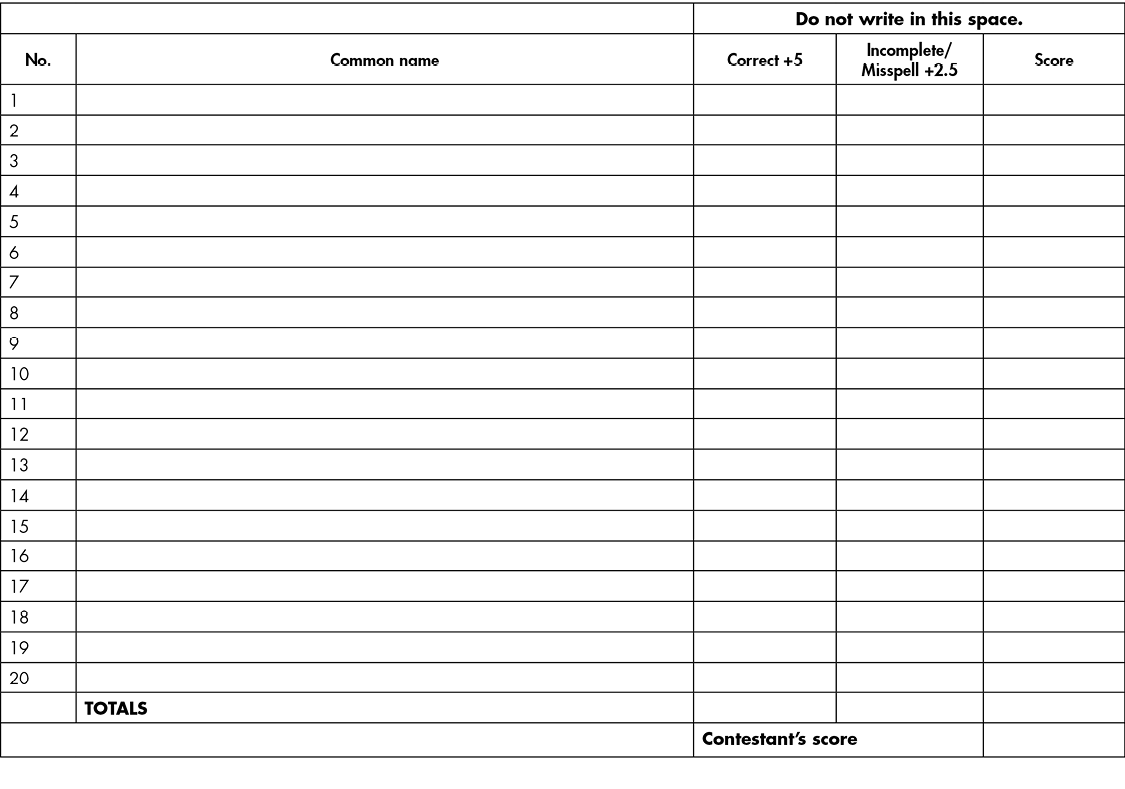
Publication 1991 (POD-10-23)
Revised by Brady Self, PhD, Associate Extension Professor, Forestry, and James Shannon, Extension Agent II, Pontotoc County, from earlier versions by James Henderson, PhD, Extension Professor and Head, Coastal Research and Extension Center, Robert Daniels, PhD, Extension Professor (retired), and Winston Savelle, former Extension Associate.
The Mississippi State University Extension Service is working to ensure all web content is accessible to all users. If you need assistance accessing any of our content, please email the webteam or call 662-325-2262.




